Personal Offers
- Published
- 4 min reading

The concept of personalizing marketing activities goes back to the 1990s. However, simply targeting an offer based on manually pre-defined segments or personalizing a message by using the recipient’s name is no longer enough to engage the desired audience. The emerging standard of hyper-personalization or individualization of marketing activities used to be considered as impossible due to technical limitations. However, together with technological progress and the growing availability of collected data, what used to be beyond the imagination of marketers has now become reality.
Levels of offer personalization
Personalizing a sale offer to an individual customer may happen on various levels, depending on the desired size of the targeted audience and varying technical and business complexity. As a general rule, higher personalization levels require more complex technological solutions and carry a higher degree of risk, but also may result in a much more significant set of business benefits.

Figure 1 - Levels of offer personalization
1. Mass offer
The most generic and broadest type of marketing activity with little or no defined targeting.
Example: A mass email campaign to the entire customer base, or a 5% discount on all products in a defined timeframe.
2. Loyalty offer
A mass offer, narrowed down to a specific brand. Alternatively, a basic loyalty program-driven campaign.
Example: Buy one, get one free and/or get double loyalty points for specific FMCG brand products
3. Targeted offer
An offer with a specified target audience, which is usually pre-defined as a segment based on a set of selected customer attributes (e.g. demographics) or purchase history.
Example: Special price for an item for customers in a specific age group and who have bought items from the same category in the past.
4. Personalized offer
A type of a targeted or loyalty offer, but with additional features making it more relevant or unique at the individual customer level.
Example: Double loyalty points for all purchases for two weeks starting on a member’s birthday.
5. Individualized/hyper-personalized offer
The next level of personalization, when customers receive an individual offer based on their preferences, activities and behavior. In the ideal conditions, each individualized offer is unique.
Example: Discount on a category of products for customer A if they have not purchased anything for more than two weeks, or bonus reward for a customer who is redeeming their loyalty points in a consistent manner.
Comparison of key elements of various personalization levels
| Typical goal | Size of the addressed target group | Technical / business complexity | Potential risks / challenges | |
| Mass |
| Entire customer base | Low |
|
| Loyalty |
| Entire customer base or members of a loyalty program | Medium | Usually requires investment in a loyalty program platform |
| Targeted |
| Segment of a customer base | Medium to high |
|
| Personalized |
| Individuals or segments addressed in a personal manner | High |
|
| Individualized | Individuals | High to very high |
Why is personalization worth attention?
Having introduced various levels of offer personalization, it is now worth discussing why it is worth investing inpersonalization.
1. It is effective
There are many publicly available case studies, success stories and academic research papers that describe the implementation of marketing offer personalization resulting in a range of both quantitative or qualitative benefits. Some examples include:
- Increasing conversion rate
By adapting the landing page of an e-commerce venture based on the individual customer search and purchase history, or personalizing an online B2C interaction experience in any other way, it is possible to achieve a significant boost in the conversion rate. As an example, Dutch insurance company FBTO reported a 15% increase in conversion rates after implementing real-time personalization technology and individualized messaging based on website activity, browsing history and more. They also personalized the follow-up communication to visitors who left their website without purchasing anything, and managed to convert an additional 30% of them. [1] - Increasing the perceived value of an offer
In the case of loyalty programs, rewards that are appealing to one group of members and become the sole reason for their further engagement with the program may be completely irrelevant to another group. An extensive study carried out by the University of Strasbourg in 2013 investigated how different types of rewards in a frequent flyer program impacted overall member loyalty, measured in purchase intensity and resistance to counter-persuasion. One of the main findings was that, depending on the customer motivation and purchase orientation, the perceived value of the same reward will vary. Thus, it is highly beneficial to target and personalize rewards accordingly as it correlates with the metrics measuring the overall customer loyalty. [2] - Improving customer engagement
From the customer relationship management perspective, offer personalization leads to higher rates of product or service satisfaction among customers at all stages of the B2C relationship lifecycle. This applies especially to the acquisition and retention stages, as research proves that offer personalization results in increased word-of-mouth marketing and leads to more effective win-back campaigns for clients whose interaction has been decreasing. Overall, it is approximated that the adoption of a personalization strategy leads to a 26% increase in profitability and a 12% greater market capitalization [3].
2. It became a standard in many industries and it goes along with shifting customers’ expectations
In 2013, Infosys released a study resulting from data collected from 1 000 consumers and 50 retailers in the United States Some of the key findings include:
- 59% of consumers who have experienced personalization believe it has a noticeable influence on their purchase decisions
- 62% are highly in favor of personalized offers/promotions based on previous experiences
- Four personalization benefits that were most commonly cited by the retailers were an increase in sales (72%), an increase in profit (61%), an increase in online traffic (58%), and an increase in customer loyalty (55%)
- 62% of retailers had already implemented offer personalization technology, and a further 20% planned to do so in the near future [4]
The most straightforward conclusion is that, even six years ago, personalization was a direct method of meeting customers’ expectations, and retailers have only confirmed its effectiveness. Since then, the only thing that has changed is that it is no longer an innovation or a big leap forward, but more of a standard for marketers working in the retail industry.
Why is traditional personalization no longer enough?
Segment-based personalization has clear benefits. However, it has always been considered as a compromise between a mass offer and a vision of a one-to-one, individualized approach between the company and their end consumer. Shifting from segmentation towards individualized offers has one overarching benefit - avoiding the narrow majority trap.
Imagine a situation where a segment-based personalization system attempts to determine the next best offer for customers in a segment consisting of clients who have all purchased product A in the past illustrated in Figure 2:
 Figure 2 - Narrow majority illustration
Figure 2 - Narrow majority illustration
In this example, three out of 10 members of the segment purchased product B after purchasing product A. Therefore, if we wanted to apply a very simple segment-based next best offer logic, all of the newly added segment members should be offered product B. However, this approach completely ignores the fact that the remaining 70% of members did not purchase product B. Therefore, the next best offer in this scenario is completely dependent on the narrow majority of segment members and their purchase decisions, despite its low actual accuracy. [5]
Sources
[1] PR Newswire Association LLC, “Instant 15% Increase in Convertion Rates for FBTO Due to Magiq's Digital Trigger-Based Marketing and Real-Time Personalisation Technology,” PR Newswire Association LLC, New York, 2009.
[2] L. Meyer-Waarden, “The impact of reward personalisation on frequent flyer programmes' perceived value and loyalty,” Journal of Services Marketing, vol. 27, no. 3, pp. 183-194, 2013.
[3] A. Bleier, A. De Keyser and K. Verleye, Customer Engagement Through Personalization and Customization., R. W. Palmatier, V. Kumar and C. M. Harmeling, Eds., Cham: Palgrave Macmillan, 2018.
[4] Infosys, “Rethinking Retail,” Infosys Limited, Bangalore, India, 2013.
[5] J. Brown, “The Future of Customer Engagement and Commerce,” 14 September 2018. [Online]. Available: http://www.the-future-of-commerce.com/2018/09/14/marketing-evolution-personalization-to-individualization/.



